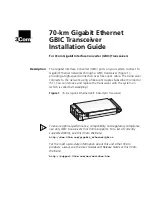
8.7 Interface Board Features
The locations of the LEDs on the interface board that are used by the DNT24 are shown in Figure 8.8.1.
Figure 8.8.1
DCD LED, D11, illuminates on a router or remote to indicate it is registered with its parent and can participate in RF com-
munications. The DCD LED illuminates on the base when one or more routers or
remotes are registered to it, unless the base has been configured to assert DCD on power up. In this case it will be on as
long as the development board is powered. Activity LED, D10, illuminates when transmitting or receiving RF data. Power
LED, D1, illuminates with the DNT24 and its interface board are powered. GPIO2 LED, D5, and GPIO3 LED, D4, can be
controlled by configuring GPIO2 and GPIO3 as outputs on the DNT24. These LEDs are illuminated with a logic high sig-
nal.
Figure 8.8.2
Figure 8.8.2 shows the connectors and switches to the right of the DNT24P mounting socket. JP3 and JP4 normally have
shorting plugs installed as shown in Figure 8.8.2. JP3 connects ADC0 to the yellow potentiometer. Clockwise rotation of
the potentiometer increases the voltage. JP4 connects ADC1 to a thermistor temperature sensor. The DNT24 has its own
boot loader utility that allows the protocol firmware to be installed with a terminal program that supports YMODEM. The
©2009-2014 by Murata Electronics N.A., Inc.
DNT24 Integration Guide R2.0 - 10/27/14
www.murata.com
Содержание DNT24 Series
Страница 79: ...Figure 10 3 2 2009 2014 by Murata Electronics N A Inc DNT24 Integration Guide R2 0 10 27 14 www murata com...
Страница 80: ...Figure 10 3 3 2009 2014 by Murata Electronics N A Inc DNT24 Integration Guide R2 0 10 27 14 www murata com...
Страница 82: ...2009 2014 by Murata Electronics N A Inc DNT24 Integration Guide R2 0 10 27 14 www murata com...
Страница 83: ...2009 2014 by Murata Electronics N A Inc DNT24 Integration Guide R2 0 10 27 14 www murata com...











































